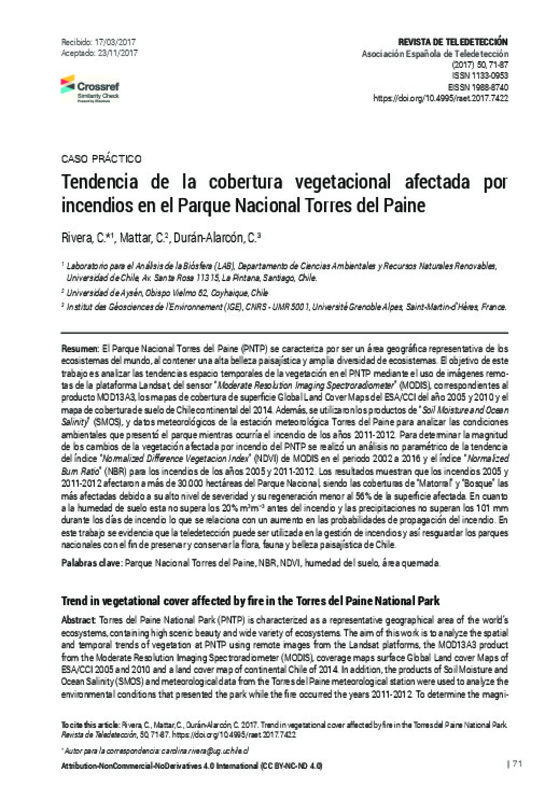|
Resumen:
|
[EN] Torres del Paine National Park (PNTP) is characterized as a representative geographical area of the world’s ecosystems, containing high scenic beauty and wide variety of ecosystems. The aim of this work is to analyze ...[+]
[EN] Torres del Paine National Park (PNTP) is characterized as a representative geographical area of the world’s ecosystems, containing high scenic beauty and wide variety of ecosystems. The aim of this work is to analyze the spatial and temporal trends of vegetation at PNTP using remote images from the Landsat platforms, the MOD13A3 product from the Moderate Resolution Imaging Spectroradiometer (MODIS), coverage maps surface Global Land cover Maps of ESA/CCI 2005 and 2010 and a land cover map of continental Chile of 2014. In addition, the products of Soil Moisture and Ocean Salinity (SMOS) and meteorological data from the Torres del Paine meteorological station were used to analyze the environmental conditions that presented the park while the fire occurred the years 2011-2012. To determine the magnitude of the changes of vegetation affected by fire at PNTP a nonparametric trend analysis was use with the Normalized Difference Vegetation Index (NDVI) of MODIS from 2002 to 2016 and the Normalized Burn Ratio (NBR) for the fire occurred the year 2005 and the years 2011-2012. The results show that between both fires it is been affected more than 30.000 hectares of the national park, being the “Scrub” and “Forest” coverage the most affected due to the high level of severity and the low regeneration of the burn area (less than 56%). The soil moisture does not exceed 20% m3m-3 before the fire and the rainfall does not exceed 101 mm during the days of fire, which is related to an increase in the probability of propagation of the fire. In this work is possible to realize that remote sensing can be used in the fire management to regard the national parks with the objective of preserve and conserve the flora, fauna and scenic beauty of Chile.
[-]
[ES] El Parque Nacional Torres del Paine (PNTP) se caracteriza por ser un área geográfica representativa de los ecosistemas del mundo, al contener una alta belleza paisajística y amplia diversidad de ecosistemas. El objetivo ...[+]
[ES] El Parque Nacional Torres del Paine (PNTP) se caracteriza por ser un área geográfica representativa de los ecosistemas del mundo, al contener una alta belleza paisajística y amplia diversidad de ecosistemas. El objetivo de este trabajo es analizar las tendencias espacio temporales de la vegetación en el PNTP mediante el uso de imágenes remotas de la plataforma Landsat, del sensor “Moderate Resolution Imaging Spectroradiometer” (MODIS), correspondientes al producto MOD13A3, los mapas de cobertura de superficie Global Land Cover Maps del ESA/CCI del año 2005 y 2010 y el mapa de cobertura de suelo de Chile continental del 2014. Además, se utilizaron los productos de “Soil Moisture and Ocean Salinity” (SMOS), y datos meteorológicos de la estación meteorológica Torres del Paine para analizar las condiciones ambientales que presentó el parque mientras ocurría el incendio de los años 2011-2012. Para determinar la magnitud de los cambios de la vegetación afectada por incendio del PNTP se realizó un análisis no paramétrico de la tendencia del índice “Normalized Difference Vegetacion Index” (NDVI) de MODIS en el periodo 2002 a 2016 y el índice “Normalized Burn Ratio” (NBR) para los incendios de los años 2005 y 2011-2012. Los resultados muestran que los incendios 2005 y 2011-2012 afectaron a más de 30.000 hectáreas del Parque Nacional, siendo las coberturas de “Matorral” y “Bosque” las más afectadas debido a su alto nivel de severidad y su regeneración menor al 56% de la superficie afectada. En cuanto a la humedad de suelo esta no supera los 20% m3m–3 antes del incendio y las precipitaciones no superan los 101 mm durante los días de incendio lo que se relaciona con un aumento en las probabilidades de propagación del incendio. En este trabajo se evidencia que la teledetección puede ser utilizada en la gestión de incendios y así resguardar los parques nacionales con el fin de preservar y conservar la flora, fauna y belleza paisajística de Chile.
[-]
|
|
Agradecimientos:
|
Gracias al proyecto Conicyt – Fondecyt Iniciación 11130359 “Estimating the Surface soil moisture at regional scale by using a synergic optical-passive microwave approach and remote sensing data”, a United States Geological ...[+]
Gracias al proyecto Conicyt – Fondecyt Iniciación 11130359 “Estimating the Surface soil moisture at regional scale by using a synergic optical-passive microwave approach and remote sensing data”, a United States Geological Survery (USGS) por el libre acceso a los datos Landsat-5 TM, Landsat-7 ETM+ y Landsat-8 OLI, a la National Aeronautics and Space (NASA) por los productos MODIS y la Dra. María Piles por los productos de humedad de suelo SMOS.
[-]
|








